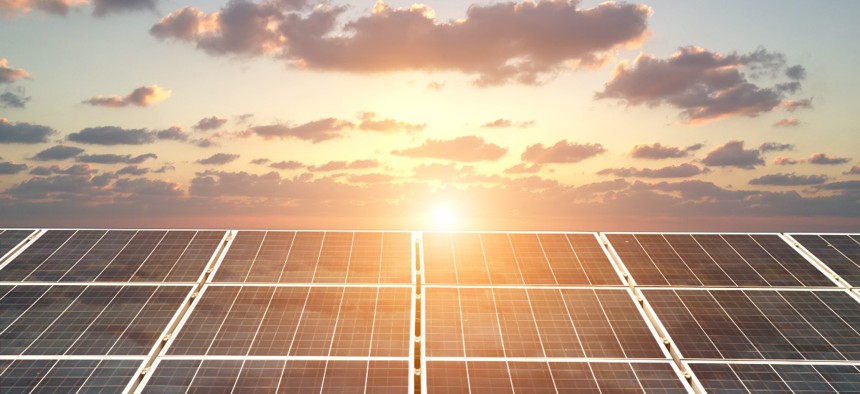
alexsl/Getty Images
GSA Tests Energy Tech to Achieve Federal Sustainability Goals
The agency is looking at solar tracking, off-grid mobile charging and carbon pollution-free electricity to meet goals set in a December 2021 executive order.
The General Services Administration is exploring several energy technologies to help federal agencies and buildings adhere to goals set in President Joe Biden’s December 2021 executive order promoting federal leadership in sustainability.
GSA’s Center for Emerging Building Technology launched its Applied Innovation Learning Laboratory project at the Bean Federal Center in Indianapolis to test off-grid mobile charging and solar tracking technology to support electric vehicle supply equipment and solar energy production, respectively. Bean Federal Center has been a site for other green technology efforts, such as the installation of rooftop solar panels in 2011.
The initiative includes a renewable, transportable electric vehicle charging station “that combines solar, battery storage and emergency power and can be independent or grid-tied,” and a single-axis, low-cost solar tracker “that increases energy yield of commercial rooftop photovoltaic production by adapting a proven utility tracking technology.”
GSA partnered with the Energy Department’s Sandia National Laboratories to plan an analysis of both pilots—which are designed to support GSA’s ability to fulfill commitments in Biden’s December 2021 executive order, with a goal of net-zero emission in the government’s buildings by 2045 and an all-electric federal government fleet by 2035. In addition to Sandia Laboratories, BEAM Global and Rocking Solar helped to plan the pilots.
“We’re thrilled to collaborate with innovative companies to test new clean energy technologies that support net-zero emission buildings and vehicle charging infrastructure at federal properties,” GSA Commissioner of the Public Buildings Service Nina Albert said. “Providing the space for practical testing of sustainable technologies is vital to accelerating the transition to an all-electric fleet and building a cleaner, healthier future for the country.”
“The Inflation Reduction Act will provide even more opportunities for GSA’s Green Proving Ground program to drive data-driven investment in emerging and sustainable technologies,” Kevin Powell, director of GSA’s Center for Emerging Building Technology, said. “Building and fleet electrification is at a transformational moment, and we’re thrilled to be partnering with the Bean Federal Center to understand how we can best derive optimum value for rooftop solar and all-electric fleets.”
GSA also announced that, as part of the Biden administration’s new memorandum of understanding, GSA will work with utility company Entergy Arkansas—“one of the top 10 suppliers of electricity to the federal government”—to help federal agencies in Arkansas meet the goals set in the December 2021 executive order. Specifically, the MOU will address the goal for all of the federal government’s electricity to be carbon pollution-free by 2030, with at least 50% of this electricity designated as 24/7 carbon-free electricity—meaning it is “procured to match actual electricity consumption on an hourly basis and produced within the same regional grid where the energy is consumed,” according to the executive order.
“This MOU marks a historic step forward and demonstrates how the federal government is partnering in initiatives to spur demand for carbon pollution-free electricity—when and where people need it,” GSA Administrator Robin Carnahan said. “GSA looks forward to working with our agency partners and utilities across the country to replicate this MOU model—helping to promote local, clean energy sources and catalyze utility-scale energy storage and create a more resilient grid.”
Entergy Arkansas will utilize regional nuclear and renewable energy like solar, hydro or wind to provide this carbon pollution-free electricity.
According to GSA, the program is one of the first electricity utility tariffs with 24/7 hourly matching of carbon pollution-free electricity with customer consumption needs, while combining current and new carbon pollution-free electricity creation.







